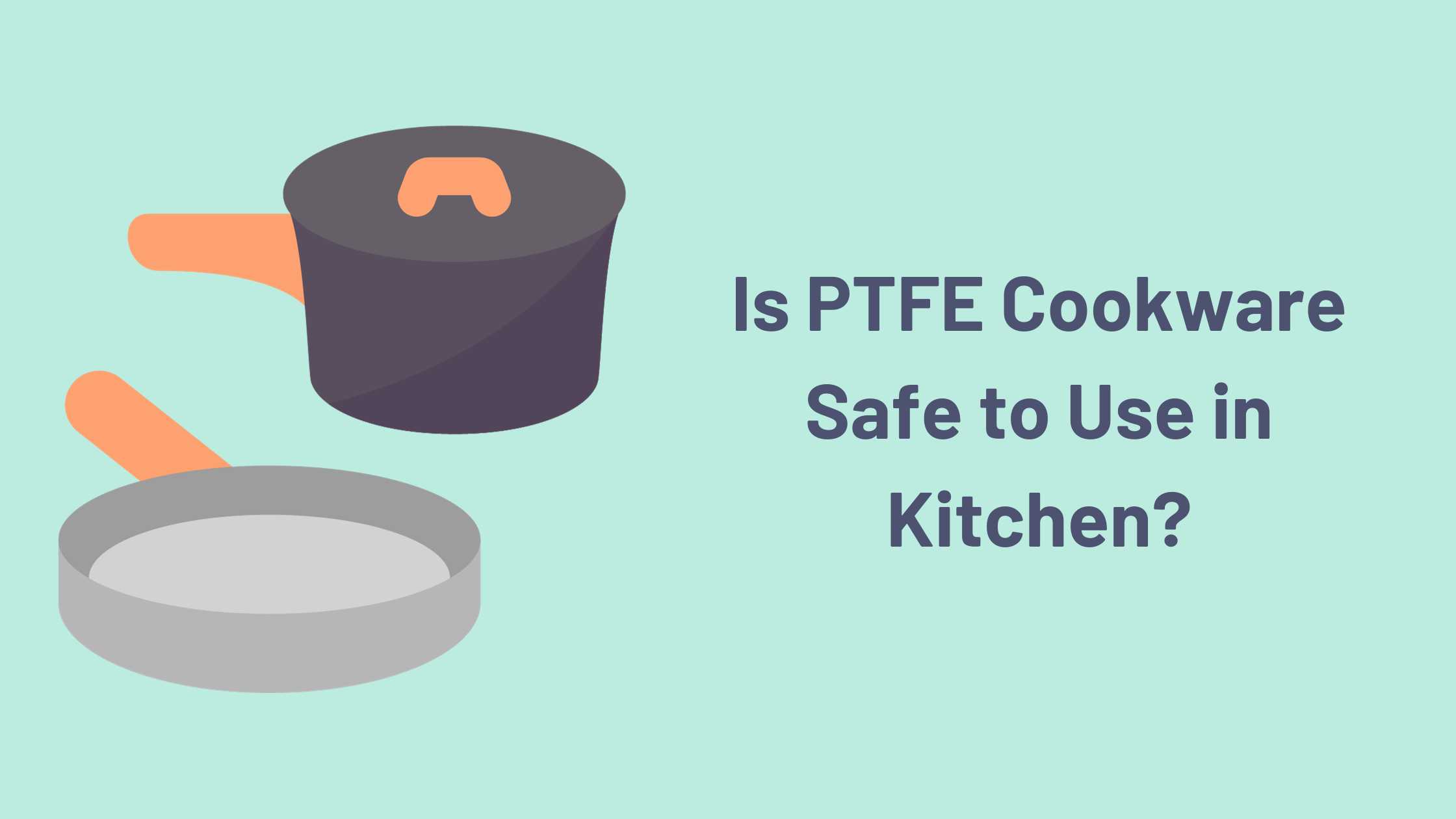
Is PTFE Cookware Safe to Use in Kitchen?
PTFE is a synthetic polymer that has been used in non-stick cookware for decades, but concerns have been raised about the potential health risks associated with its use. Recent studies suggest that when PTFE-coated pans are overheated, they can release toxic fumes and particles into the air, which may cause flu-like symptoms in humans and have adverse effects on pet birds. While the majority of experts agree that properly used PTFE cookware does not pose a significant health risk, it’s important to be cautious and avoid overheating these pans.
The key to using PTFE cookware safely lies in following manufacturer’s recommendations and avoiding exposing the cookware to extreme heat. By using low or medium heat settings rather than high heat, you can prevent any potential release of harmful chemicals. Additionally, using silicone or wooden utensils instead of metal ones can prevent scratching and prolong the lifespan of your PTFE cookware. With proper care and usage, the Boohgle Cookware Set provides a safe and convenient option for your kitchen needs.
One alternative to traditional PTFE cookware is ceramic-coated pans, which are gaining popularity due to their non-toxic nature. Ceramic-coated cookware is made from natural materials like clay and sand, making it free from harmful chemicals such as PFOA or PFAS. These pans offer similar non-stick properties without the potential health concerns associated with PTFE coatings.
Stainless steel cookware provides a durable and versatile option for those looking to avoid synthetic coatings altogether. With growing awareness of potential health risks associated with conventional non-stick cookware, consumers now have a wide range of safer alternatives to choose from for their kitchen needs. While many sources claim properly used PTFE cookware is safe for everyday cooking, there are valid concerns about the potential health risks when these pans are overheated or damaged.
Individuals seeking peace of mind may want to consider switching to ceramic-coated or stainless steel options as safer alternatives for their kitchen endeavors. Ultimately, making an informed decision about the type of cookware to use involves weighing the trade-offs between convenience and safety.
Among these surfaces, Polytetrafluoroethylene (PTFE) coating has been popular for its non-stick properties. However, concerns about potential health risks associated with PTFE-coated cookware have led to the development of innovative alternatives such as the Catalytic Flouro-Ceramic Hybrid Coating. In this comprehensive exploration, we delve into the dangers of using PTFE cookware, the benefits of transitioning to the new Catalytic Flouro-Ceramic Hybrid Coating, and why it represents a safer and more efficient choice for cooking.
Understanding PTFE Cookware: Pros and Cons
Pros of PTFE Cookware:
- Non-Stick Properties: PTFE-coated cookware is renowned for its non-stick capabilities, allowing for easy food release and effortless cleaning.
- Heat Resistance: PTFE coatings exhibit high-temperature resistance, making them suitable for various cooking methods, including searing and high-heat frying.
- Affordability: Cookware with PTFE coatings tends to be relatively affordable compared to other options in the market.
Cons of PTFE Cookware:
- Health Concerns: One of the primary drawbacks associated with PTFE-coated cookware is the potential release of toxic fumes at high temperatures. When heated beyond 500°F (260°C), PTFE coatings can emit perfluorooctanoic acid (PFOA) and other harmful compounds, posing health risks.
- Scratching and Wear: PTFE coatings can be susceptible to scratching, leading to the potential ingestion of small particles and compromising the non-stick properties over time.
- Environmental Impact: The production and disposal of PTFE-coated cookware can have adverse environmental effects due to the presence of perfluorinated chemicals that do not readily break down in nature.
The Emergence of Catalytic Flouro-Ceramic Hybrid Coating
In response to the concerns surrounding PTFE coatings, the introduction of the Catalytic Flouro-Ceramic Hybrid Coating represents a significant advancement in cookware technology. This innovative coating is engineered to mitigate the risks associated with traditional PTFE while offering enhanced performance and safety features.
Why Use Catalytic Flouro-Ceramic Hybrid Coating?
- Enhanced Safety: Unlike PTFE coatings, the Catalytic Flouro-Ceramic Hybrid Coating is designed to withstand higher temperatures without emitting harmful fumes. Its composition and structure reduce the risks associated with overheating, providing a safer cooking experience.
- Durability and Performance: This hybrid coating exhibits exceptional durability, resisting scratches and wear while maintaining its non-stick properties over a more extended period. The enhanced durability contributes to a longer lifespan for the cookware.
- Reduced Environmental Impact: The manufacturing process and materials used in the Catalytic Flouro-Ceramic Hybrid Coating aim to minimize environmental harm, aligning with sustainable practices and reducing the release of harmful chemicals into the environment.
One of the key advantages of using Catalytic Fluoro-Ceramic Hybrid Coating is its eco-friendly nature. By leveraging catalytic technology, this coating actively decomposes harmful pollutants in the surrounding environment through a self-cleaning process. This unique feature not only reduces maintenance requirements but also contributes to a cleaner and healthier living or working space. Furthermore, compared to traditional coatings that require frequent reapplications and touch-ups, this hybrid solution offers long-term protection with minimal environmental impact. Boohgle Home users can benefit from enhanced sustainability while enjoying durable surface protection with this cutting-edge technology.
Understanding the Technology Behind Catalytic Flouro-Ceramic Hybrid Coating
The Catalytic Flouro-Ceramic Hybrid Coating incorporates a unique blend of ceramic and fluoropolymer components. The ceramic elements contribute to the coating’s durability and heat resistance, while the fluoropolymer components aid in maintaining its non-stick properties. What sets this coating apart is its catalytic properties, which enable it to break down potentially harmful substances at temperatures that would otherwise cause traditional PTFE coatings to release toxic fumes.
Enhanced Safety Measures with Up to 8 Times the Usual Safety Levels
Our patented Catalytic Flouro-Ceramic Hybrid Coating offers an unprecedented level of safety, surpassing typical safety standards by up to eight times. Through meticulous research and development, we have engineered this coating to exceed safety thresholds, providing consumers with an extra layer of confidence in their cookware choices.
FAQs
1. What is Catalytic Flouro-Ceramic Hybrid Coating?
Catalytic Flouro-Ceramic Hybrid Coating is an innovative surface treatment for cookware that combines ceramic and fluoropolymer components. It’s designed to offer enhanced durability, non-stick properties, and improved safety compared to traditional PTFE coatings.
2. How does Catalytic Flouro-Ceramic Hybrid Coating differ from PTFE coatings?
Unlike PTFE coatings, Catalytic Flouro-Ceramic Hybrid Coating is engineered to withstand higher temperatures without releasing harmful fumes. Its catalytic properties allow it to break down potentially harmful substances, offering an increased level of safety.
3. Is Catalytic Flouro-Ceramic Hybrid Coating environmentally friendly?
Yes, this coating aims to reduce environmental impact. Its manufacturing process and composition are designed to minimize harm to the environment by limiting the release of harmful chemicals during use and disposal.
4. Does Catalytic Flouro-Ceramic Hybrid Coating maintain non-stick properties over time?
Yes, this hybrid coating is engineered to maintain its non-stick properties for an extended period. Its durability helps retain the non-stick feature despite regular use and cleaning.
5. What is the temperature threshold for Catalytic Flouro-Ceramic Hybrid Coating?
The Catalytic Flouro-Ceramic Hybrid Coating can withstand higher temperatures compared to traditional PTFE coatings, reducing the risk of emitting harmful fumes. It is designed to remain safe even at temperatures where PTFE coatings might degrade.
6. Can Catalytic Flouro-Ceramic Hybrid Coating scratch easily?
This hybrid coating exhibits exceptional durability against scratches and wear, reducing the likelihood of particles flaking off into food and maintaining its non-stick properties for longer periods.
7. Is Catalytic Flouro-Ceramic Hybrid Coating suitable for all types of cookware?
Yes, this coating can be applied to various types of cookware, including pans, pots, baking sheets, and other kitchen utensils.
8. How should I care for cookware with Catalytic Flouro-Ceramic Hybrid Coating?
Regular handwashing with mild detergent and a soft sponge or cloth is recommended to maintain the coating’s performance. Avoid abrasive cleaners or utensils that could scratch the surface.
9. Does cooking with Catalytic Flouro-Ceramic Hybrid Coating affect food taste?
No, this coating is designed to be inert and does not affect the taste or quality of food. It provides a safe and neutral surface for cooking various types of dishes.
10. Is Catalytic Flouro-Ceramic Hybrid Coating safe for use in ovens and dishwashers?
Yes, cookware treated with this coating is generally safe for use in ovens and dishwashers. However, always refer to specific manufacturer instructions for the recommended temperature limits and dishwasher guidelines for optimal care.
Conclusion
As consumers become increasingly conscious of health and environmental concerns, the shift from traditional PTFE-coated cookware to safer alternatives like the Catalytic Flouro-Ceramic Hybrid Coating marks a pivotal step in the culinary industry. With its improved safety features, durability, and reduced environmental impact, this innovative coating represents the future of non-stick cookware technology, offering a compelling solution for health-conscious individuals seeking a safer and more sustainable cooking experience.






